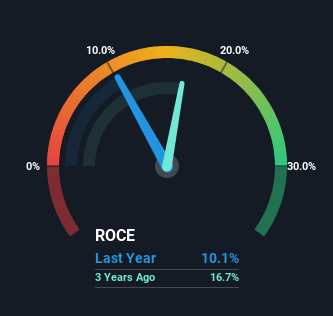
If you're looking for a multi-bagger, there's a few things to keep an eye out for. Firstly, we'd want to identify a growing return on capital employed (ROCE) and then alongside that, an ever-increasing base of capital employed. Ultimately, this demonstrates that it's a business that is reinvesting profits at increasing rates of return. In light of that, when we looked at Lygend Resources & Technology (HKG:2245) and its ROCE trend, we weren't exactly thrilled.
Understanding Return On Capital Employed (ROCE)
For those that aren't sure what ROCE is, it measures the amount of pre-tax profits a company can generate from the capital employed in its business. The formula for this calculation on Lygend Resources & Technology is:
Return on Capital Employed = Earnings Before Interest and Tax (EBIT) ÷ (Total Assets - Current Liabilities)
0.10 = CN¥2.3b ÷ (CN¥35b - CN¥12b) (Based on the trailing twelve months to June 2024).
Therefore, Lygend Resources & Technology has an ROCE of 10%. By itself that's a normal return on capital and it's in line with the industry's average returns of 10%.
Check out our latest analysis for Lygend Resources & Technology

While the past is not representative of the future, it can be helpful to know how a company has performed historically, which is why we have this chart above. If you're interested in investigating Lygend Resources & Technology's past further, check out this free graph covering Lygend Resources & Technology's past earnings, revenue and cash flow.
What Does the ROCE Trend For Lygend Resources & Technology Tell Us?
On the surface, the trend of ROCE at Lygend Resources & Technology doesn't inspire confidence. To be more specific, ROCE has fallen from 60% over the last four years. Although, given both revenue and the amount of assets employed in the business have increased, it could suggest the company is investing in growth, and the extra capital has led to a short-term reduction in ROCE. If these investments prove successful, this can bode very well for long term stock performance.
On a side note, Lygend Resources & Technology has done well to pay down its current liabilities to 34% of total assets. That could partly explain why the ROCE has dropped. Effectively this means their suppliers or short-term creditors are funding less of the business, which reduces some elements of risk. Since the business is basically funding more of its operations with it's own money, you could argue this has made the business less efficient at generating ROCE.
In Conclusion...
While returns have fallen for Lygend Resources & Technology in recent times, we're encouraged to see that sales are growing and that the business is reinvesting in its operations. In light of this, the stock has only gained 1.8% over the last year. So this stock may still be an appealing investment opportunity, if other fundamentals prove to be sound.
One more thing: We've identified 3 warning signs with Lygend Resources & Technology (at least 2 which shouldn't be ignored) , and understanding these would certainly be useful.
While Lygend Resources & Technology may not currently earn the highest returns, we've compiled a list of companies that currently earn more than 25% return on equity. Check out this free list here.
Have feedback on this article? Concerned about the content? Get in touch with us directly. Alternatively, email editorial-team (at) simplywallst.com.
This article by Simply Wall St is general in nature. We provide commentary based on historical data and analyst forecasts only using an unbiased methodology and our articles are not intended to be financial advice. It does not constitute a recommendation to buy or sell any stock, and does not take account of your objectives, or your financial situation. We aim to bring you long-term focused analysis driven by fundamental data. Note that our analysis may not factor in the latest price-sensitive company announcements or qualitative material. Simply Wall St has no position in any stocks mentioned.